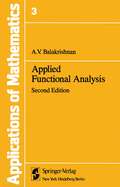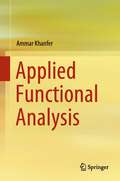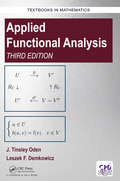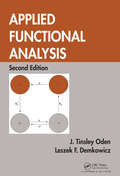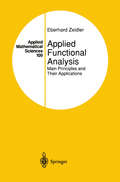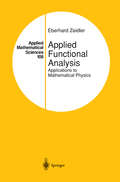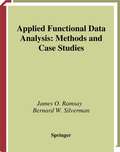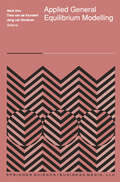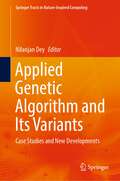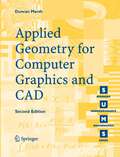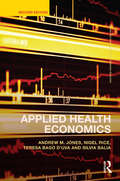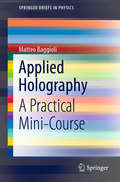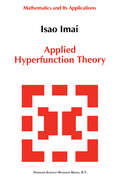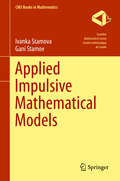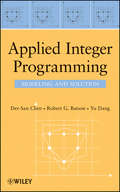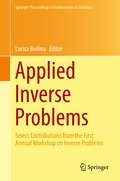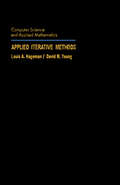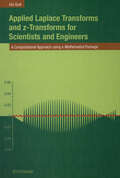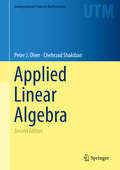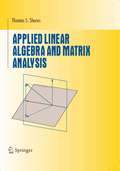- Table View
- List View
Applied Fractional Calculus in Identification and Control (Studies in Infrastructure and Control)
by Utkal Mehta Kishore Bingi Sahaj SaxenaThe book investigates the fractional calculus-based approaches and their benefits to adopting in complex real-time areas. Another objective is to provide initial solutions for new areas where fractional theory has yet to verify the expertise. The book focuses on the latest scientific interest and illustrates the basic idea of general fractional calculus with MATLAB codes. This book is ideal for researchers working on fractional calculus theory both in simulation and hardware. Researchers from academia and industry working or starting research in applied fractional calculus methods will find the book most useful. The scope of this book covers most of the theoretical and practical studies on linear and nonlinear systems using fractional-order integro-differential operators.
Applied Functional Analysis (Pure and Applied Mathematics: A Wiley Series of Texts, Monographs and Tracts #47)
by Jean-Pierre AubinA novel, practical introduction to functional analysis In the twenty years since the first edition of Applied Functional Analysis was published, there has been an explosion in the number of books on functional analysis. Yet none of these offers the unique perspective of this new edition. Jean-Pierre Aubin updates his popular reference on functional analysis with new insights and recent discoveries-adding three new chapters on set-valued analysis and convex analysis, viability kernels and capture basins, and first-order partial differential equations. He presents, for the first time at an introductory level, the extension of differential calculus in the framework of both the theory of distributions and set-valued analysis, and discusses their application for studying boundary-value problems for elliptic and parabolic partial differential equations and for systems of first-order partial differential equations. To keep the presentation concise and accessible, Jean-Pierre Aubin introduces functional analysis through the simple Hilbertian structure. He seamlessly blends pure mathematics with applied areas that illustrate the theory, incorporating a broad range of examples from numerical analysis, systems theory, calculus of variations, control and optimization theory, convex and nonsmooth analysis, and more. Finally, a summary of the essential theorems as well as exercises reinforcing key concepts are provided. Applied Functional Analysis, Second Edition is an excellent and timely resource for both pure and applied mathematicians.
Applied Functional Analysis: a (Stochastic Modelling and Applied Probability #3)
by Alampallam V. BalakrishnanIn preparing the second edition, I have taken advantage of the opportunity to correct errors as well as revise the presentation in many places. New material has been included, in addition, reflecting relevant recent work. The help of many colleagues (and especially Professor J. Stoer) in ferreting out errors is gratefully acknowledged. I also owe special thanks to Professor v. Sazonov for many discussions on the white noise theory in Chapter 6. February, 1981 A. V. BALAKRISHNAN v Preface to the First Edition The title "Applied Functional Analysis" is intended to be short for "Functional analysis in a Hilbert space and certain of its applications," the applications being drawn mostly from areas variously referred to as system optimization or control systems or systems analysis. One of the signs of the times is a discernible tilt toward application in mathematics and conversely a greater level of mathematical sophistication in the application areas such as economics or system science, both spurred undoubtedly by the heightening pace of digital computer usage. This book is an entry into this twilight zone. The aspects of functional analysis treated here are rapidly becoming essential in the training at the advance graduate level of system scientists and/or mathematical economists. There are of course now available many excellent treatises on functional analysis.
Applied Functional Analysis (Textbooks in Mathematics)
by J. Tinsley Oden Leszek DemkowiczApplied Functional Analysis, Third Edition provides a solid mathematical foundation for the subject. It motivates students to study functional analysis by providing many contemporary applications and examples drawn from mechanics and science. This well-received textbook starts with a thorough introduction to modern mathematics before continuing with detailed coverage of linear algebra, Lebesque measure and integration theory, plus topology with metric spaces. The final two chapters provides readers with an in-depth look at the theory of Banach and Hilbert spaces before concluding with a brief introduction to Spectral Theory. The Third Edition is more accessible and promotes interest and motivation among students to prepare them for studying the mathematical aspects of numerical analysis and the mathematical theory of finite elements.
Applied Functional Analysis (Textbooks In Mathematics Ser.)
by J. Tinsley Oden Leszek DemkowiczThrough numerous illustrative examples and comments, Applied Functional Analysis, Second Edition demonstrates the rigor of logic and systematic, mathematical thinking. It presents the mathematical foundations that lead to classical results in functional analysis. More specifically, the text prepares students to learn the variational theory of parti
Applied Functional Analysis (Textbooks in Mathematics)
by J. Tinsley Oden Leszek DemkowiczApplied Functional Analysis, Third Edition provides a solid mathematical foundation for the subject. It motivates students to study functional analysis by providing many contemporary applications and examples drawn from mechanics and science. This well-received textbook starts with a thorough introduction to modern mathematics before continuing with detailed coverage of linear algebra, Lebesque measure and integration theory, plus topology with metric spaces. The final two chapters provides readers with an in-depth look at the theory of Banach and Hilbert spaces before concluding with a brief introduction to Spectral Theory. The Third Edition is more accessible and promotes interest and motivation among students to prepare them for studying the mathematical aspects of numerical analysis and the mathematical theory of finite elements.
Applied Functional Analysis: Main Principles and Their Applications (Applied Mathematical Sciences #109)
by Eberhard ZeidlerThe second part of an elementary textbook which combines linear functional analysis, nonlinear functional analysis, and their substantial applications. The book addresses undergraduates and beginning graduates of mathematics, physics, and engineering who want to learn how functional analysis elegantly solves mathematical problems which relate to our real world and which play an important role in the history of mathematics. The books approach is to attempt to determine the most important applications. These concern integral equations, differential equations, bifurcation theory, the moment problem, Cebysev approximation, the optimal control of rockets, game theory, symmetries and conservation laws, the quark model, and gauge theory in elementary particle physics. The presentation is self-contained and requires only that readers be familiar with some basic facts of calculus.
Applied Functional Analysis: Applications to Mathematical Physics (Applied Mathematical Sciences #108)
by Eberhard ZeidlerThe first part of a self-contained, elementary textbook, combining linear functional analysis, nonlinear functional analysis, numerical functional analysis, and their substantial applications with each other. As such, the book addresses undergraduate students and beginning graduate students of mathematics, physics, and engineering who want to learn how functional analysis elegantly solves mathematical problems which relate to our real world. Applications concern ordinary and partial differential equations, the method of finite elements, integral equations, special functions, both the Schroedinger approach and the Feynman approach to quantum physics, and quantum statistics. As a prerequisite, readers should be familiar with some basic facts of calculus. The second part has been published under the title, Applied Functional Analysis: Main Principles and Their Applications.
Applied Functional Data Analysis: Methods and Case Studies (Springer Series in Statistics)
by J.O. Ramsay B.W. SilvermanThis book contains the ideas of functional data analysis by a number of case studies. The case studies are accessible to research workers in a wide range of disciplines. Every reader should gain not only a specific understanding of the methods of functional data analysis, but more importantly a general insight into the underlying patterns of thought. There is an associated web site with MATLABr and S?PLUSr implementations of the methods discussed.
Applied General Equilibrium Modelling
by Henk Don Theo C. M. J. Van De Klundert Jarig Van SinderenOver the last decade or so, applied general equilibrium models have rapidly become a major tool for policy advice on issues regarding allocation and efficiency, most notably taxes and tariffs. This reflects the power of the general equilibrium approach to allocative questions and the capability of today's applied models to come up with realistic answers. However, it by no means implies that the theoretical, practical and empirical problems faced by researchers in applied modelling have all been solved in a satisfactory way. Rather, a promising field of research has been opened up, inviting theorists and practitioners to further explore and exploit its potential. The state of the art in applied general equilibrium modelling is reflected in this volume. The introductory Chapter (Part I) evaluates the use of economic modelling to address policy questions, and discusses the advantages and disadvantages of applied general equilibrium models. Three substantive issues are dealt with in Chapters 2-8: Tax Reform and Capital (Part II), Intertemporal Aspects and Expectations (Part III), and Taxes and the Labour Market (Part IV). While all parts contain results relevant for economic policy, it is clear that theory and applications for these areas are in different stages of development. We hope that this book will bring inspiration, insight and information to researchers, students and policy advisors.
Applied Genetic Algorithm and Its Variants: Case Studies and New Developments (Springer Tracts in Nature-Inspired Computing)
by Nilanjan DeyThis book provides fundamental concepts related to various types of genetic algorithms and practical applications in various domains such as medical imaging, manufacturing, and engineering design. The book discusses genetic algorithms which are used to solve a variety of optimization problems. The genetic algorithms are demonstrated to offer reliable search in complex spaces. The book presents high-quality research work by academics and researchers which is useful for young researchers and students.
Applied Geometry for Computer Graphics and CAD (Springer Undergraduate Mathematics Series)
by Duncan MarshFocusing on the manipulation and representation of geometrical objects, this book explores the application of geometry to computer graphics and computer-aided design (CAD). Over 300 exercises are included, some new to this edition, and many of which encourage the reader to implement the techniques and algorithms discussed through the use of a computer package with graphing and computer algebra capabilities. A dedicated website also offers further resources and useful links.
Applied Health Economics
by Andrew M. Jones Nigel Rice Teresa Bago D'Uva Silvia BaliaThe first edition of Applied Health Economics did an expert job of showing how the availability of large scale data sets and the rapid advancement of advanced econometric techniques can help health economists and health professionals make sense of information better than ever before. This second edition has been revised and updated throughout and includes a new chapter on the description and modelling of individual health care costs, thus broadening the book’s readership to those working on risk adjustment and health technology appraisal. The text also fully reflects the very latest advances in the health economics field and the key journal literature. Large-scale survey datasets, in particular complex survey designs such as panel data, provide a rich source of information for health economists. They offer the scope to control for individual heterogeneity and to model the dynamics of individual behaviour. However, the measures of outcome used in health economics are often qualitative or categorical. These create special problems for estimating econometric models. The dramatic growth in computing power over recent years has been accompanied by the development of methods that help to solve these problems. The purpose of this book is to provide a practical guide to the skills required to put these techniques into practice. Practical applications of the methods are illustrated using data on health from the British Health and Lifestyle Survey (HALS), the British Household Panel Survey (BHPS), the European Community Household Panel (ECHP), the US Medical Expenditure Panel Survey (MEPS) and Survey of Health, Ageing and Retirement in Europe (SHARE). There is a strong emphasis on applied work, illustrating the use of relevant computer software with code provided for Stata. Familiarity with the basic syntax and structure of Stata is assumed. The Stata code and extracts from the statistical output are embedded directly in the main text and explained at regular intervals. The book is built around empirical case studies, rather than general theory, and the emphasis is on learning by example. It presents a detailed dissection of methods and results of some recent research papers written by the authors and their colleagues. Relevant methods are presented alongside the Stata code that can be used to implement them and the empirical results are discussed at each stage. This text brings together the theory and application of health economics and econometrics, and will be a valuable reference for applied economists and students of health economics and applied econometrics.
Applied Health Economics
by Andrew M. Jones Nigel Rice Teresa Bago D'Uva Silvia BaliaThe first edition of Applied Health Economics did an expert job of showing how the availability of large scale data sets and the rapid advancement of advanced econometric techniques can help health economists and health professionals make sense of information better than ever before. This second edition has been revised and updated throughout and includes a new chapter on the description and modelling of individual health care costs, thus broadening the book’s readership to those working on risk adjustment and health technology appraisal. The text also fully reflects the very latest advances in the health economics field and the key journal literature. Large-scale survey datasets, in particular complex survey designs such as panel data, provide a rich source of information for health economists. They offer the scope to control for individual heterogeneity and to model the dynamics of individual behaviour. However, the measures of outcome used in health economics are often qualitative or categorical. These create special problems for estimating econometric models. The dramatic growth in computing power over recent years has been accompanied by the development of methods that help to solve these problems. The purpose of this book is to provide a practical guide to the skills required to put these techniques into practice. Practical applications of the methods are illustrated using data on health from the British Health and Lifestyle Survey (HALS), the British Household Panel Survey (BHPS), the European Community Household Panel (ECHP), the US Medical Expenditure Panel Survey (MEPS) and Survey of Health, Ageing and Retirement in Europe (SHARE). There is a strong emphasis on applied work, illustrating the use of relevant computer software with code provided for Stata. Familiarity with the basic syntax and structure of Stata is assumed. The Stata code and extracts from the statistical output are embedded directly in the main text and explained at regular intervals. The book is built around empirical case studies, rather than general theory, and the emphasis is on learning by example. It presents a detailed dissection of methods and results of some recent research papers written by the authors and their colleagues. Relevant methods are presented alongside the Stata code that can be used to implement them and the empirical results are discussed at each stage. This text brings together the theory and application of health economics and econometrics, and will be a valuable reference for applied economists and students of health economics and applied econometrics.
Applied Holography: A Practical Mini-Course (SpringerBriefs in Physics)
by Matteo BaggioliThis primer is a collection of notes based on lectures that were originally given at IIT Madras (India) and at IFT Madrid (Spain). It is a concise and pragmatic course on applied holography focusing on the basic analytic and numerical techniques involved. The presented lectures are not intended to provide all the fundamental theoretical background, which can be found in the available literature, but they concentrate on concrete applications of AdS/CFT to hydrodynamics, quantum chromodynamics and condensed matter. The idea is to accompany the reader step by step through the various benchmark examples with a classmate attitude, providing details for the computations and open-source numerical codes in Mathematica, and sharing simple tricks and warnings collected during the author’s research experience. At the end of this path, the reader will be in possess of all the fundamental skills and tools to learn by him/herself more advanced techniques and to produce independent and novel research in the field.
Applied Hyperfunction Theory (Mathematics and its Applications #8)
by Isao ImaiGeneralized functions are now widely recognized as important mathematical tools for engineers and physicists. But they are considered to be inaccessible for non-specialists. To remedy this situation, this book gives an intelligible exposition of generalized functions based on Sato's hyperfunction, which is essentially the `boundary value of analytic functions'. An intuitive image -- hyperfunction = vortex layer -- is adopted, and only an elementary knowledge of complex function theory is assumed. The treatment is entirely self-contained. The first part of the book gives a detailed account of fundamental operations such as the four arithmetical operations applicable to hyperfunctions, namely differentiation, integration, and convolution, as well as Fourier transform. Fourier series are seen to be nothing but periodic hyperfunctions. In the second part, based on the general theory, the Hilbert transform and Poisson-Schwarz integral formula are treated and their application to integral equations is studied. A great number of formulas obtained in the course of treatment are summarized as tables in the appendix. In particular, those concerning convolution, the Hilbert transform and Fourier transform contain much new material. For mathematicians, mathematical physicists and engineers whose work involves generalized functions.
Applied Impulsive Mathematical Models (CMS Books in Mathematics)
by Ivanka Stamova Gani StamovUsing the theory of impulsive differential equations, this book focuses on mathematical models which reflect current research in biology, population dynamics, neural networks and economics. The authors provide the basic background from the fundamental theory and give a systematic exposition of recent results related to the qualitative analysis of impulsive mathematical models. Consisting of six chapters, the book presents many applicable techniques, making them available in a single source easily accessible to researchers interested in mathematical models and their applications. Serving as a valuable reference, this text is addressed to a wide audience of professionals, including mathematicians, applied researchers and practitioners.
Applied Integer Programming: Modeling and Solution
by Der-San Chen Robert G. Batson Yu DangAn accessible treatment of the modeling and solution of integer programming problems, featuring modern applications and software In order to fully comprehend the algorithms associated with integer programming, it is important to understand not only how algorithms work, but also why they work. Applied Integer Programming features a unique emphasis on this point, focusing on problem modeling and solution using commercial software. Taking an application-oriented approach, this book addresses the art and science of mathematical modeling related to the mixed integer programming (MIP) framework and discusses the algorithms and associated practices that enable those models to be solved most efficiently. The book begins with coverage of successful applications, systematic modeling procedures, typical model types, transformation of non-MIP models, combinatorial optimization problem models, and automatic preprocessing to obtain a better formulation. Subsequent chapters present algebraic and geometric basic concepts of linear programming theory and network flows needed for understanding integer programming. Finally, the book concludes with classical and modern solution approaches as well as the key components for building an integrated software system capable of solving large-scale integer programming and combinatorial optimization problems. Throughout the book, the authors demonstrate essential concepts through numerous examples and figures. Each new concept or algorithm is accompanied by a numerical example, and, where applicable, graphics are used to draw together diverse problems or approaches into a unified whole. In addition, features of solution approaches found in today's commercial software are identified throughout the book. Thoroughly classroom-tested, Applied Integer Programming is an excellent book for integer programming courses at the upper-undergraduate and graduate levels. It also serves as a well-organized reference for professionals, software developers, and analysts who work in the fields of applied mathematics, computer science, operations research, management science, and engineering and use integer-programming techniques to model and solve real-world optimization problems.
Applied Integer Programming: Modeling and Solution
by Der-San Chen Robert G. Batson Yu DangAn accessible treatment of the modeling and solution of integer programming problems, featuring modern applications and software In order to fully comprehend the algorithms associated with integer programming, it is important to understand not only how algorithms work, but also why they work. Applied Integer Programming features a unique emphasis on this point, focusing on problem modeling and solution using commercial software. Taking an application-oriented approach, this book addresses the art and science of mathematical modeling related to the mixed integer programming (MIP) framework and discusses the algorithms and associated practices that enable those models to be solved most efficiently. The book begins with coverage of successful applications, systematic modeling procedures, typical model types, transformation of non-MIP models, combinatorial optimization problem models, and automatic preprocessing to obtain a better formulation. Subsequent chapters present algebraic and geometric basic concepts of linear programming theory and network flows needed for understanding integer programming. Finally, the book concludes with classical and modern solution approaches as well as the key components for building an integrated software system capable of solving large-scale integer programming and combinatorial optimization problems. Throughout the book, the authors demonstrate essential concepts through numerous examples and figures. Each new concept or algorithm is accompanied by a numerical example, and, where applicable, graphics are used to draw together diverse problems or approaches into a unified whole. In addition, features of solution approaches found in today's commercial software are identified throughout the book. Thoroughly classroom-tested, Applied Integer Programming is an excellent book for integer programming courses at the upper-undergraduate and graduate levels. It also serves as a well-organized reference for professionals, software developers, and analysts who work in the fields of applied mathematics, computer science, operations research, management science, and engineering and use integer-programming techniques to model and solve real-world optimization problems.
Applied Inverse Problems: Select Contributions from the First Annual Workshop on Inverse Problems (Springer Proceedings in Mathematics & Statistics #48)
by Larisa BeilinaThis proceedings volume is based on papers presented at the First Annual Workshop on Inverse Problems which was held in June 2011 at the Department of Mathematics, Chalmers University of Technology. The purpose of the workshop was to present new analytical developments and numerical methods for solutions of inverse problems. State-of-the-art and future challenges in solving inverse problems for a broad range of applications was also discussed. The contributions in this volume are reflective of these themes and will be beneficial to researchers in this area.
Applied Laplace Transforms and z-Transforms for Scientists and Engineers: A Computational Approach using a Mathematica Package
by Urs GrafThe theory of Laplace transformation is an important part of the mathematical background required for engineers, physicists and mathematicians. Laplace transformation methods provide easy and effective techniques for solving many problems arising in various fields of science and engineering, especially for solving differential equations. What the Laplace transformation does in the field of differential equations, the z-transformation achieves for difference equations. The two theories are parallel and have many analogies. Laplace and z transformations are also referred to as operational calculus, but this notion is also used in a more restricted sense to denote the operational calculus of Mikusinski. This book does not use the operational calculus of Mikusinski, whose approach is based on abstract algebra and is not readily accessible to engineers and scientists. The symbolic computation capability of Mathematica can now be used in favor of the Laplace and z-transformations. The first version of the Mathematica Package LaplaceAndzTransforrns developed by the author appeared ten years ago. The Package computes not only Laplace and z-transforms but also includes many routines from various domains of applications. Upon loading the Package, about one hundred and fifty new commands are added to the built-in commands of Mathematica. The code is placed in front of the already built-in code of Laplace and z-transformations of Mathematica so that built-in functions not covered by the Package remain available. The Package substantially enhances the Laplace and z-transformation facilities of Mathematica. The book is mainly designed for readers working in the field of applications.
Applied Linear Algebra (Undergraduate Texts in Mathematics)
by Peter J. Olver Chehrzad ShakibanThis textbook develops the essential tools of linear algebra, with the goal of imparting technique alongside contextual understanding. Applications go hand-in-hand with theory, each reinforcing and explaining the other. This approach encourages students to develop not only the technical proficiency needed to go on to further study, but an appreciation for when, why, and how the tools of linear algebra can be used across modern applied mathematics.Providing an extensive treatment of essential topics such as Gaussian elimination, inner products and norms, and eigenvalues and singular values, this text can be used for an in-depth first course, or an application-driven second course in linear algebra. In this second edition, applications have been updated and expanded to include numerical methods, dynamical systems, data analysis, and signal processing, while the pedagogical flow of the core material has been improved. Throughout, the text emphasizes the conceptual connections between each application and the underlying linear algebraic techniques, thereby enabling students not only to learn how to apply the mathematical tools in routine contexts, but also to understand what is required to adapt to unusual or emerging problems.No previous knowledge of linear algebra is needed to approach this text, with single-variable calculus as the only formal prerequisite. However, the reader will need to draw upon some mathematical maturity to engage in the increasing abstraction inherent to the subject. Once equipped with the main tools and concepts from this book, students will be prepared for further study in differential equations, numerical analysis, data science and statistics, and a broad range of applications. The first author’s text, Introduction to Partial Differential Equations, is an ideal companion volume, forming a natural extension of the linear mathematical methods developed here.
Applied Linear Algebra and Matrix Analysis (Undergraduate Texts in Mathematics)
by Thomas S. ShoresThis new book offers a fresh approach to matrix and linear algebra by providing a balanced blend of applications, theory, and computation, while highlighting their interdependence. Intended for a one-semester course, Applied Linear Algebra and Matrix Analysis places special emphasis on linear algebra as an experimental science, with numerous examples, computer exercises, and projects. While the flavor is heavily computational and experimental, the text is independent of specific hardware or software platforms. Throughout the book, significant motivating examples are woven into the text, and each section ends with a set of exercises.


